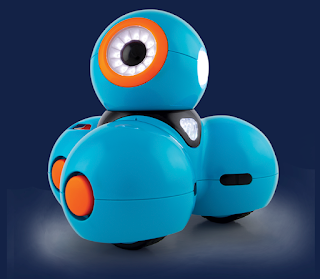I have heard of Dash and Dot Robots before and I have seen them, but I have never taken the opportunity to learn anything about them. My current school library has Dash and Dot and I have seen them during our school's district Technology Fair, however I never thought about using them in the classroom until now. While Dash is still around, Dot is now part of Dash's virtual world and is still her best friend. Dash is also available in a virtual world (paid version) where a classroom can all be engaged at the same time without having to have a physical robot in front of them.
Dash is a programable robot that can move, sing, dance, flash lights, respond to voices, make sounds, and tell a story (Wonder Workshop, n.d.). Students learn to code through self-directed and guided play. Dash uses the software Blockly. In the software, students can follow guided pathways for their grade level. There are 10-15 activities which take about 15-20 minutes a piece. Teachers can monitor student progress on a dashboard and it will alert teachers if a student looks to be stuck.
The R.A.T. model was developed by Dr. Joan Hughes in 1998. This model was created by Dr. Hughes to help her understand the nature of technology-supported practices teachers develop and implemented into their classrooms. R.A.T stands for Replacement, Amplification, and Transformation.
Replacement: Technology is used to replace, and not change, the way student learning processes, instructional practices, and content goals are implemented. All that changes in Replacement is the means that the content is delivered (digitally).
Amplification: In Amplification, technology increases capabilities. Technology increases efficiency, effectiveness, and productivity of instructional practices, student learning process, or content goals.
Transformation: In Transformation, technology invents instruction, learning, or curriculum in new, fun, and original ways.
While thinking about how this software could be used in the classroom, I came across a section in the Make Wonder page that lists different aspects of the technology. In the Make Wonder software, math activties, coding, science activities, and read aloud support are all included. The math activities are meant for grades 3-5. However, as a teacher I know that students in younger grades can be working at higher levels. This would be a great way to ensure students are working at their level and it would serve as Amplification in the R.A.T. model. For younger readers, instructions in the software can use the read-aloud feature to help support them in following the directions. The other section I feel that could be implemented would be the science section. This section is provided for grades K-5 and it includes teaching science along with the coding concepts of sequence, looping, and events. The Make Wonder Software also includes lessons that can be implemented in Math, Science, Social Studies, and Reading.
While researching this product, I went ahead and signed up for the Free version and I plan to borrow Dash and Dot from our school librarian to use in my classroom this year. I am hopeful that it will add to the curriculum and allow students to work through coding skills as well. Due to the time restriction for my core curriculum, I will begin by implementing this during our workstation/small group time. I also plan to talk to our technology teacher and STEM teacher to see if they have used this in their classroom at all and if not I will ask if this is something they could do in their classroom to supplement what is being done in my classroom.
To learn more about the Make Wonder Free version for teachers and to sign up click here
Tp purchase and learn more about Dash and the Wonder Workshop click here
References
Dash robot from Wonder Workshop. Wonder Workshop. (n.d.). https://store.makewonder.com/products/dash?srsltid=AfmBOoqqR1J6t6r5o9hAnklUaYfV1Uto22HU8_a4G976c6IfGzMmQSJQ
R.A.T. model. Dr. Joan E. Hughes | TechEdges | Technology Integration Research. (2016, June 24). https://web.archive.org/web/20190612101737/https://techedges.org/r-a-t-model/





Dash and Dot robots sound very interesting! I have never heard of them until reading your blog. They sound like a fun, interactive learning tool to assist with making lessons more interactive. I do like that the teacher will get an alert if a student seems to be stuck throughout their activity. I am interested to see the robot function within a classroom setting.
ReplyDelete